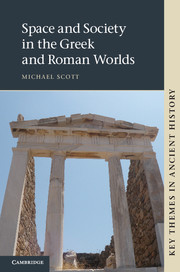Book contents
- Frontmatter
- Contents
- Illustrations
- Acknowledgements
- Abbreviations
- Introduction
- Chapter 1 Inheriting and articulating a community
- Chapter 2 Networks of polytheism: spaces for the gods at Delos
- Chapter 3 Spaces of alienation: street-lining Roman cemeteries
- Chapter 4 A spatial approach to relationships between colony and metropolis
- Chapter 5 The place of Greece in the oikoumene of Strabo’s Geography
- Conclusion: space and society in the Greek and Roman worlds
- Bibliographic essay
- Bibliography
- Index
Chapter 3 - Spaces of alienation: street-lining Roman cemeteries
Published online by Cambridge University Press: 05 December 2012
- Frontmatter
- Contents
- Illustrations
- Acknowledgements
- Abbreviations
- Introduction
- Chapter 1 Inheriting and articulating a community
- Chapter 2 Networks of polytheism: spaces for the gods at Delos
- Chapter 3 Spaces of alienation: street-lining Roman cemeteries
- Chapter 4 A spatial approach to relationships between colony and metropolis
- Chapter 5 The place of Greece in the oikoumene of Strabo’s Geography
- Conclusion: space and society in the Greek and Roman worlds
- Bibliographic essay
- Bibliography
- Index
Summary
Introduction
There is an immense array of scholarship on death and burial in the Roman world, covering a wide range of investigative approaches and types of evidence. In particular, previous scholarship has highlighted both a series of overarching factors affecting and a conventional development timeline for the design and location of Roman tombs. Those factors range from the changing preference for inhumation or cremation and the changing rules surrounding burial to the acculturation of different styles in different parts of the Roman world. The timeline charts a move from modest graves in the early Republic to more showy and ornate tombs located in arenas of high visibility peaking in the late Republic, followed by an even wider diversity of communal tomb forms (columbaria) in the early Empire. The popularity of stone monuments tails off from the end of the second century AD, and even columbaria gradually give way to the use of underground catacombs in the third and (particularly) fourth centuries AD as the role of the cemetery and the importance of tombs as display markers shifted (cf. Bodel 2008; Hope 2009: 162).
Yet even scholars who have published widely in this area highlight the need for more work to be done, especially that which places these tombs fully within their spatial environment (e.g. Koortbojian 1996: 211; Jaeger 1997: 26; Larmour and Spencer 2007: 7; Hope 2009: 153, 159, 186). This is an opportune moment at which to respond to such a call. There has recently been a renewed interest in understanding the complexities of urban space and how it was perceived (e.g. the importance of mobility, procession and other kinds of action within urban space: Hope and Huskinson 2011; Laurence and Newsome 2011; O’Sullivan 2011). Equally, the importance and meaning of the major Roman roads along which these tombs lay have recently been re-emphasised, with a special focus on their spatial dimensions as connectors between different arenas of activity (e.g. Jackson 1984: 26–7; Dyson 1992: 148; Lomas 1998; Laurence 1999: 157–8; Hope 2009: 155; Spencer 2010: 55). Most importantly, the ‘suburbs’ of Roman cities, where many of these tombs were located, have also recently been under the spotlight, revealing the much more complex interplay between social, economic and political activities, as well as the way in which they mediated the wider relationship between city and countryside (e.g. Purcell 1987; Hope 2000c; Patterson 2000; Coates-Stephens 2004; Graham 2005; Gray 2006; Rosen and Sluiter 2006; Hope 2009: 154–5, 176–7).
- Type
- Chapter
- Information
- Space and Society in the Greek and Roman Worlds , pp. 77 - 109Publisher: Cambridge University PressPrint publication year: 2012



